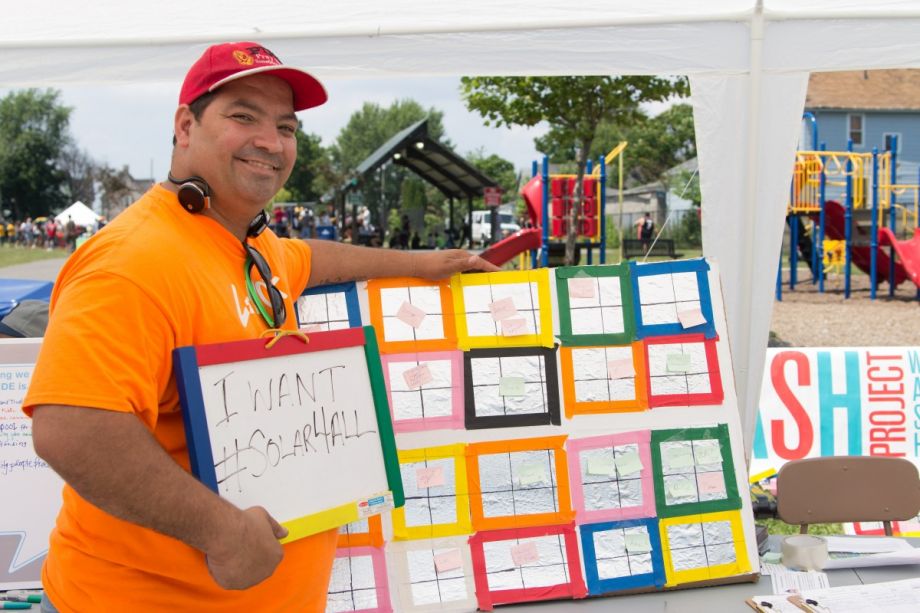One hundred years ago, Buffalo was an industrial hub and an early adopter of a new form of power: electricity. Then, the electric lights that transformed the night and powered factories ran thanks to Niagara Falls’ tremendous energy. Deindustrialization, however, made Buffalo synonymous with the “rust belt” and left more than half of its children living in poverty.
Yet since the 2009 financial crisis, Buffalo has been experiencing a sort of renaissance as investors recognize the potential of the city’s stately housing. Buffalo has the oldest housing stock in the nation, with 64 percent built prior to 1940. The influx of cash, however, has also meant some residents are being displaced. “We don’t want [people from working class and communities of color] to get lost during this transition,” says Rahwa Ghirmatzion, executive director of PUSH Buffalo.
To combat that displacement, PUSH Buffalo —People United for Sustainable Housing — proposes creating affordable housing powered with renewable energy. In November, the nonprofit developer received a $400,000 grant from the Kresge Foundation to use arts and culture to further that mission.
Buffalo faces a number of challenges on the road to equitable development. In addition to high poverty and unemployment, cold winters mean a bump in heating bills, and in some areas of the city, property taxes have increased as much as 1000 percent, says Ghirmatzion. To engage a broader swath of local residents in organizing activities, Ghirmatzion says PUSH Buffalo has used the arts and creative approaches. Having a broader, more diverse base means a greater ability to advocate for the green-energy and affordable housing solutions PUSH proposes.
“What we have really tried to embed as an anti-gentrification strategy, is doing cultural organizing and working with local arts institutions and local residents who are artists to help us in the visioning. From the beginning, they’re with us,” Ghirmatzion says. She points to projects such as the community solar system installed on the roof of a re-purposed local school as one example.
PUSH Buffalo spearheaded the School 77 project, converting classrooms to affordable, senior housing and creating space for businesses and community groups. Ghirmatziaon says that Ujima Company, a local theater group, facilitated a community visioning of the School 77 space. That allowed participants to place cut outs on a mock-up of the building and to physically map out how many benches there would be, how many parking spaces, and so on.
The WASH Project, a refugee-owned mixed-use laundromat which also provides social services and cultural opportunities, was another important partner in bringing neighbors into the conversation. At one outreach event, a festival held in a local park, WASH created a pop-up roller skating rink, using chalk to draw lanes on the park’s paths and basketball court.
The 2016 festival also included a concert and demonstrations of how solar panels work. “We got cardboard boxes and said ‘this is a house.’ Then we got foil and put it on top and showed them how energy distribution works,” Ghirmatzion says. “We would draw panels on the [aluminum] foil as if they were on the roof,” Ghirmatzion explains. PUSH Buffalo developed this popular education session and conducted in conjunction with the Hester Street Collaborative, an urban design non-profit founded on the idea that the people who live in neighborhoods are the ones who should shape them.
Barrett Gordon, the WASH Project’s director, says that the park event showed the power of the arts for community organizing. “Trying to channel people’s creativity has a nice way of creating a sense of a common denominator,” he says. Gordon sees both urban planning and creativity as “basic human instincts.” As a result, he says, “putting that stuff under people’s nose and reminding them how easy it can be, can work well” to get people involved in actively thinking about and designing spaces. “[Ujima and WASH] would come with us to all of the community planning meetings. They did a bunch of different engagements that used music and dance that was reflective of this community to get us to engage a larger set of residents,” Ghirmatzion says.
The experience convinced Ghirmatzion and PUSH Buffalo that involving artists in community development and planning transforms those processes. “I think what it did was to broaden the impact of what we were designing and to engage stakeholders in a such a different way that the things that we are building are much more useful and relevant to the people who will be using them,” she says. Ghirmatzion says that one focus group even gathered input from 5- to 10-year olds.
PUSH Buffalo’s efforts to create and protect affordable housing are important as the city gentrifies. Ghirmatzion says the city has raised property taxes in some neighborhoods by as much as 500 to 1000 percent. Such increases risk pushing low-income residents out.
Rob Galbraith is a senior research analyst for the Public Accountability Initiative, a think tank that researches corporate power. He says that when the City of Buffalo reassessed property values last year for the first time in nearly twenty years, tax bills skyrocketed for many. “Certain neighborhoods that are facing the strongest pressure from gentrification have seen their property values really, in this latest assessment, just jump through the roof,” Galbraith says. While some homebuyers are simply looking for an affordable home, Galbraith notes that property speculators have played a significant role in creating this situation.
This pressure on property values make PUSH Buffalo’s creative engagement efforts a critical element in the struggle to ensure housing equity.
Creative engagement is also crucial for bridging cultures. Ghirmatzion says the West Side of Buffalo represents a wealth of cultural diversity compared to the rest of the city, and while that diversity makes the area a good place to live, it also means that residents may have cultural and language barriers that make it challenging for them to communicate easily with each other. To help bridge those differences, PUSH brought a group called Afro-Beat to perform music at the 2016 park festival. “They are incredibly global,” Ghirmatzion says of the group. “So there is something in [their music] for everyone.”
Likewise, Ghirmatzion stresses that people have different learning styles, so using a range of engagement strategies allows people to participate in the activity that suits them best. For example, while cardboard models offered one explanation of solar energy, PUSH Buffalo staff also conducted tours of the net-zero house the organization had built. Ghirmatzion says these tours were a way to “show them and not tell them” about renewable energy’s potential.
PUSH Buffalo’s next project will have 53 units of affordable housing in a complex that uses no gas and is built to net-zero standards. The same complex will include 16 units of supportive housing for people struggling with mental health issues or drug addiction and facing homelessness. Local arts institutions are on board to help with the planning process for this project over the next 18 months, Ghirmatzion says. “Maybe something really beautiful will come out of this,” she says. “Whatever it is, though, it’s of and from the community. It’s what the people want. It’s also telling their story in a way that embeds our culture and heritage as an anti-displacement strategy.”
This article is part of “For Whom, By Whom,” a series of articles about how creative placemaking can expand opportunities for low-income people living in disinvested communities. This series is generously underwritten by the Kresge Foundation.

Zoe Sullivan is a multimedia journalist and visual artist with experience on the U.S. Gulf Coast, Argentina, Brazil, and Kenya. Her radio work has appeared on outlets such as BBC, Marketplace, Radio France International, Free Speech Radio News and DW. Her writing has appeared on outlets such as The Guardian, Al Jazeera America and The Crisis.
Follow Zoe .(JavaScript must be enabled to view this email address)



_920_614_600_350_80_s_c1.jpg)

_600_350_80_s_c1.JPG)










